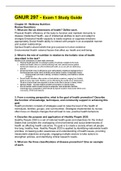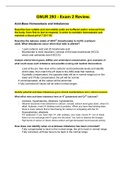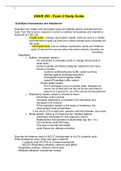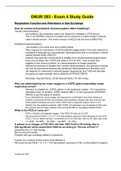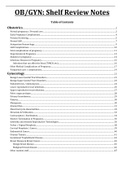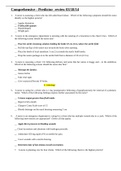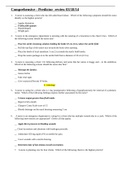Loyola University Chicago
Latest uploads at Loyola University Chicago. Looking for notes at Loyola University Chicago? We have lots of notes, study guides and study notes available for your school.
-
345
-
1
-
13
All courses for Loyola University Chicago
Popular books Loyola University Chicago
Lee Ellen Copstead, Jacquelyn L. Banasik • ISBN 9780721603384
Hedley Bull • ISBN 9780231127622
Robert Owen Keohane, Joseph S. Nye • ISBN 9780321048578
Gosta Esping-Andersen • ISBN 9780745666754
Kay Lehman Schlozman, Henry E. Brady, Sidney Verba • ISBN 9781400890361
Kenneth N. Waltz • ISBN 9781478610533
Latest notes & summaries Loyola University Chicago
GNUR 297 - Exam 1 Study Guide/GNUR 297 - Exam 1 Study Guide. Chapter 01: Wellness Nutrition Review Questions 1. What are the six dimensions of health? Define each. Physical Health- efficiency of the body to function and maintain immunity to disease Intellectual Health- use of intellectual abilities to learn and adapt to changes Emotional Health-capacity to easily express or suppress emotions appropriately Social Health-ability to interact with people in an acceptable manner and sustain rel...
GNUR 293 - Exam 2 Review/GNUR 293 - Exam 2 Review. Acid-Base Homeostasis and Imbalances Describe how volatile and nonvolatile acids are buffered and/or removed from the body, from first to last to respond, in order to maintain homeostasis and maintain a blood pH of 7.35-7.45. Describe the balance (ratio) of HCO3- (bicarbonate) to H2CO3 (carbonic acid). What imbalances occur when that ratio is altered? - 1-part carbonic acid and 20 bicarbonate acid - Bicarbonate is most important, con...
GNUR 293 - Exam 2 Study Guide/GNUR 293 - Exam 2 Study Guide Acid-Base Homeostasis and Imbalances Describe how volatile and nonvolatile acids are buffered and/or removed from the body, from first to last to respond, in order to maintain homeostasis and maintain a blood pH of 7.35-7.45. o Volatile acids: undergo vaporization rapidly. Carbonic acid is a volatile acid that forms inside our body from carbon dioxide and is excreted via the lungs. o Nonvolatile acids: Cannot undergo vaporiza...
GNUR 293 - Exam 4 Study Guide/GNUR 293 - Exam 4 Study Guide. Respiratory Function and Alterations in Gas Exchange How do central and peripheral chemoreceptors affect breathing? Central chemoreceptors: - are located in the medullary center and respond to changes in CO2 and ph. - This is our NORMAL stimulus to breathe and is caused by a small increase in arterial carbon dioxide tension. This small increase in PaCO2 tells the body to BREATHE. Peripheral chemoreceptors: - are locat...
GNUR 293 - Exam 3 Study Guide/GNUR 293 - Exam 3 Study Guide. Alterations in Blood Flow How do pressure, resistance, velocity, turbulence, compliance and Starling’s forces impact blood flow? Pressure: Blood moves from high pressure (systemic arteries) to low pressure (veins) More pressure = increased flow Increased Blood = Increased Pressure Resistance: resistance that must be overcome to push blood through the circulatory system; movement of blood through the vascular system is...
NURSING GNUR 293 - Exam 1 Study Guide/NURSING GNUR 293 - Exam 1 Study Guide. Pathophysiology Module 1: Cellular Response to Injury Three ways cells respond to injury: adapt and change structure/function, withstand and return to normal (reversible injury), or die (necrosis, apoptosis) Adaptive cellular responses: atrophy, hypertrophy, hyperplasia, metaplasia, dysplasia Atrophy – shrinking of cell SIZE; can be physiological or pathologic; general causes are disuse, denervation, ischemi...
GNUR 297 Vitamin Study Guide Chart Vitamins Role Function Deficiencies Toxicity Sources Other Thiamin (B1) Coenzymes Coenzyme in energy metabolism (carbohydrates) Converts pyruvate to acetyl-CoA for TCA cycle Role in nerve function Beriberi Wet – manifests as edema, affecting cardiac functioning Dry – no fluid overload; affects nervous system; paralysis and muscle wasting Wernicke-Korsakoff - Syndrome – mental confusion and disorientation Heart failure Anorexia/muscle wasting or weakness T...
OB-GYN Shelf Review Notes / MED 420 OB-GYN Shelf Review Notes
GNUR 294 Comprehensive ATI Predictor Review/GNUR 294 Comprehensive ATI Predictor Review/GNUR 294 Comprehensive ATI Predictor Review/GNUR 294 Comprehensive ATI Predictor Review
Comprehensive ATI- Predictor review 1. A nurse is assessing a client who has left-sided heart failure. Which of the following symptoms should the nurse identify as the highest priority? 2. A nurse in the emergency department is assisting with the suturing of a laceration to the client’s face. Which of the following actions should the nurse take? A nurse is assessing a client 1 hr following delivery and notes that her uterus is boggy and….to the umbilicus. Which of the following actions shoul...

